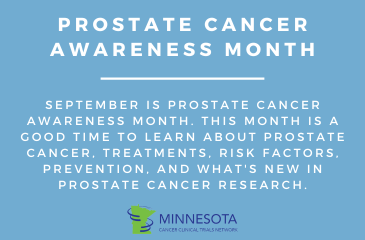Prostate Cancer Awareness Month: Using Hormones to Shrink Tumors
September is Prostate Cancer Awareness Month. This is a good time to learn about prostate cancer and its symptoms, treatments, risk factors, and prevention. Prostate cancer begins when cells in the prostate grow out of control. The prostate is a gland below the bladder that is only found in biological males. Therefore, only individuals with a prostate can develop prostate cancer. The vast majority of prostate cancer cases are adenocarcinomas. These cancers develop from gland cells in the prostate. Most prostate cancers grow slowly over time.
Prostate cancer is one of the most common types of cancers in the United States, and it is especially common in non-Hispanic Black people with prostates. Most cases are diagnosed in people over the age of 65. Prostate cancer is also the second leading cause of cancer death in American men. In 2022, about 268,000 new prostate cancer cases will be diagnosed in the United States, and 34,500 people will die from prostate cancer.
The main risk factor for prostate cancer is age, and prostate cancer is rare for people under the age of 40. Race and ethnicity are other risk factors, with African Americans and Caribbean people of African ancestry being more likely to develop prostate cancer and at younger ages. The reasons for these disparities are unclear. Some other risk factors may include geography, family history, gene changes, diet, and obesity.
Depending on the individual case, there are many different treatments for prostate cancer. Some treatment options include observation/surveillance in early stages, surgery, radiation, chemotherapy, immunotherapy, hormone therapy, or a combination of these treatments. Hormone therapy is a cancer treatment technique used on cancers that use hormones to grow, such as prostate cancer or breast cancer.
For prostate cancer, male hormones, called androgens, can stimulate prostate cancer cells to grow. The main hormones that do this are testosterone and dihydrotestosterone (DHT). Hormone therapy, or androgen suppression therapy, reduces levels of androgens in the body to stop these hormones from fueling cancer growth. It is usually given in injections or pills, or less commonly with surgery to remove parts of the body that produce hormones, such as testicles. Hormone therapy can shrink tumors or slow down their growth over time, but it cannot cure cancer on its own. This treatment is often used when prostate cancer is more advanced or cannot be treated with surgery or radiation, or if cancer returns after surgery or radiation. It can also be used before radiation therapy to try to shrink tumors to make radiation more effective.
The connection between hormones and cancer was first discovered in the 1930s to 1940s by Charles Brenton Huggins, MD. Huggins published three papers in 1941 demonstrating the relationship between prostate cancer and hormones. At this time, physicians believed that cancer growth was uncontrollable, so this was the first time that a researcher proved cancer cell growth could be caused by the body, specifically by hormones. Most importantly, this discovery proved that cancer growth could be controlled and clinicians could develop methods and treatments, like hormone therapy, to slow or even stop cancer growth.
In one study, Huggins found that injecting prostate cancer patients with testosterone caused the prostate cancer cells to activate and grow. In contrast, injecting patients with estrogen (female hormones) blocked testosterone production and reduced prostate cancer growth. In another study, Huggins tested surgery to remove the testicles, which stops the production of testosterone, on patients with prostate cancer. He found that this surgery caused tumors to shrink and relieved pain for patients. Of the 21 patients involved in Huggins’ studies, four patients lived for more than 12 years after treatment and the majority experienced relief from pain and symptoms after treatment. Huggins later extended this research to study the relationship between breast cancer and hormones in the 1950s. In 1966, Huggins received the Nobel Prize for his research on prostate cancer and hormones.
While surgery was initially used for hormone therapy, researchers wanted to find less invasive treatment methods and worked to develop hormone therapy drugs. In the 1980s, the first hormone therapy drugs were introduced. In 1981, a study was released testing a new hormone therapy on ten patients with prostate cancer. The therapy, referred to as luteinizing hormone receptor hormone antagonists, is an injection that chemically reduces the production of testosterone in the body. This slows the progression of prostate cancer. Researchers found that prostate masses in study participants reduced in size, and the majority of patients experienced pain and symptom relief and could resume activities that they couldn’t do before treatment.
Hormone therapies were further refined in the 1980s and 1990s. Research was also done on combining hormone therapy and radiation. In one study that occurred from 1987 to 1995, 415 prostate cancer patients were randomly assigned to receive either radiation alone or radiation immediately followed by hormone therapy. After five years, 79 percent of the combined radiation and hormone therapy group were alive, compared to 62 percent in the group that received radiation alone. Of those surviving patients, 85 percent of the combined radiation and hormone therapy group were cancer-free, compared to 48 percent in the group that received radiation alone. Combination radiation and hormone therapy soon became the standard treatment approach for prostate cancer as a result.
Research on hormone therapy and other treatments for prostate cancer are ongoing. Current studies continue to test new types of hormone therapy to determine the best options for patients that are safe, effective, and cause fewer side effects. Researchers have also continued to test combination therapies, including hormone therapy, radiation, chemotherapy, and surgery, as well as the timing of treatments to create the best outcomes for patients. Researchers are also using hormone therapy research to examine whether hormonal medicines, such as 5-alpha reductase inhibitors (a drug that blocks an enzyme that changes testosterone into DHT), could even prevent prostate cancer and other prostate growths.
